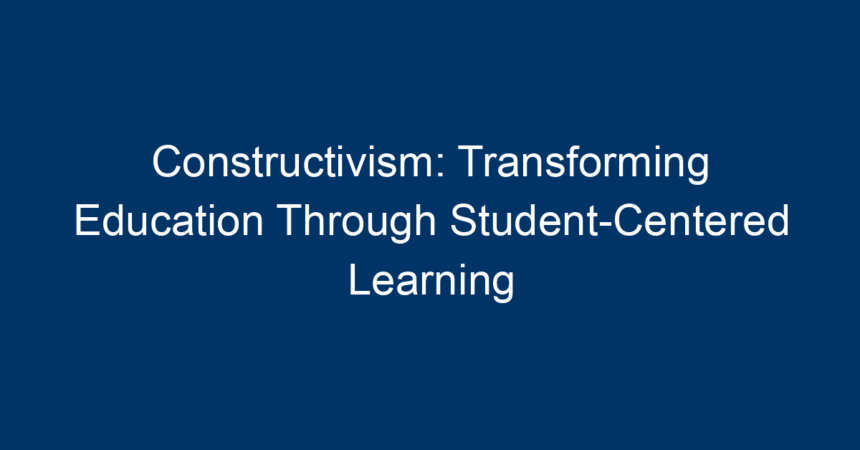In the ever-evolving landscape of education, constructivism stands out as a revolutionary approach that empowers students to take control of their own learning experiences. By shifting focus from traditional, teacher-centered instruction to student-centered learning, constructivism fosters a deeper understanding of concepts through active engagement. This article delves into the principles of constructivism, its implications for modern education, and actionable strategies for educators to implement this transformative approach.
Understanding Constructivism
What is Constructivism?
At its core, constructivism is a pedagogical philosophy asserting that learners construct their own understanding and knowledge of the world, through experiencing things and reflecting on those experiences. Originating from influential theorists such as Jean Piaget and Lev Vygotsky, constructivism emphasizes the role of social interactions and cultural contexts in shaping a learner’s cognitive development.
Key Principles of Constructivism
-
Active Learning: Constructivism promotes the idea that students learn best through hands-on experiences. Instead of passively receiving information, students engage with material, experiment, and explore.
-
Collaborative Learning: Learning is often a social endeavor. Constructivism encourages collaboration among peers, allowing students to share perspectives and learn from one another.
-
Contextual Learning: Knowledge is more meaningful when anchored in real-life contexts. Constructivist educators create learning experiences that reflect the complexities of the world outside the classroom.
- Self-Directed Learning: Constructivism fosters independence and critical thinking. Students are encouraged to take initiative and ownership of their learning journeys.
The Role of Educators in Constructivism
In a constructivist classroom, the role of the teacher shifts dramatically. Rather than being the primary source of knowledge, teachers become facilitators and guides. Here are some effective strategies for educators to implement constructivism in their classrooms:
Encouraging Inquiry-Based Learning
One of the cornerstones of constructivism is inquiry-based learning. Educators can encourage students to ask questions, investigate topics, and seek solutions to complex problems. This method ignites curiosity and fosters a love for learning.
- Example: In a science class, instead of simply lecturing on the water cycle, an educator might pose the question, “What happens to water when it’s heated?” Students can then conduct experiments to observe evaporation and condensation, leading to a deeper understanding.
Utilizing Project-Based Learning
Project-based learning (PBL) aligns seamlessly with constructivist principles. By engaging students in long-term projects that require critical thinking, collaboration, and creativity, educators can help them acquire knowledge and skills that are directly applicable to real-world situations.
- Example: A history class might involve students researching a historical event and creating a presentation. This project encourages them to utilize various sources, work together, and present their findings, honing both their research and communication skills.
Fostering a Supportive Learning Environment
A constructivist approach necessitates a classroom culture where failure is not feared but embraced as a learning opportunity. Teachers should cultivate an environment that values exploration and encourages risk-taking.
- Strategies: Regularly celebrate student efforts, provide constructive feedback, and create a safe space for discussion and questions.
Real-World Applications of Constructivism
Technology Integration
In today’s digital age, technology plays a crucial role in implementing constructivism. Educational tools such as interactive simulations, online discussion forums, and collaborative platforms enhance student engagement and allow for diverse learning experiences.
- Example: Using virtual labs in a biology class, students can conduct experiments online, allowing for experiential learning even in a remote setting.
Differentiated Instruction
Constructivism emphasizes the importance of adapting instruction to meet diverse learner needs. By differentiating content, process, and products based on student readiness, interests, and learning profiles, educators can ensure that each student has an equitable chance to succeed.
- Example: In a literature class, while some students might read a classic novel, others could engage with graphic novels or multimedia adaptations. This approach allows for a more personalized learning experience.
Assessment Reimagined
Traditional assessments often fail to capture a student’s comprehensive understanding. In a constructivist framework, formative assessments such as peer reviews, self-assessments, and project presentations provide valuable insights into students’ knowledge and learning process.
- Example: Implementing portfolios where students showcase their work and reflect on their learning journey can be a powerful assessment tool in a constructivist classroom.
Challenges and Considerations
While constructivism presents numerous benefits, there are challenges that educators may face when adopting this approach:
Resistance to Change
Transitioning from traditional methods to constructivist practices can meet resistance from both educators and students accustomed to conventional teaching styles. Professional development and support are essential to facilitate this transition.
Time Constraints
Constructivist approaches can require more time for planning and execution compared to traditional lecture-based methods. However, the long-term gains in student engagement and understanding often outweigh these initial time investments.
Diverse Learning Styles
Not all students may thrive in a constructivist environment. Some learners may prefer direct instruction or struggle with collaborative work. It’s crucial for educators to observe and address varying learning styles and offer alternative strategies.
Conclusion: Embracing Constructivism for Future-Ready Students
Adopting constructivism as a learning framework represents a crucial step towards developing critical, creative, and independent thinkers. By placing students at the center of their learning journey, educators foster a deeper understanding of content while equipping them with skills essential for success in an increasingly complex world.
Actionable Insights for Educators
-
Start Small: Begin incorporating constructivist strategies gradually. Try one new method each semester to ease the transition.
-
Collaborate with Colleagues: Share experiences and strategies with fellow educators to learn from one another.
-
Engage in Continuous Learning: Attend workshops, webinars, and courses focused on constructivist techniques to expand your knowledge.
-
Maintain Flexibility: Be open to adjusting plans based on student feedback and needs. Adaptability is essential in a constructivist classroom.
- Reflect on Practices: Regularly evaluate your teaching methods and their impact on student learning, making adjustments as necessary.
By embracing the principles of constructivism, educators not only transform their classrooms but also contribute to a more dynamic and effective educational system. The future of learning is student-centered, and with constructivism at its core, we can equip our students to thrive in an ever-changing world.




